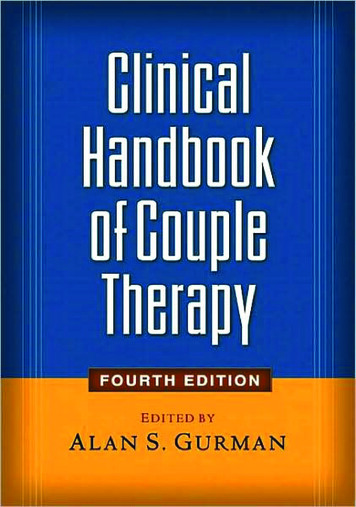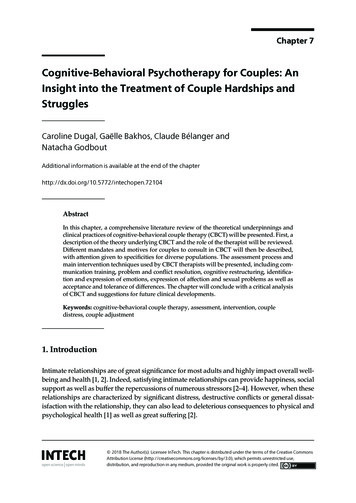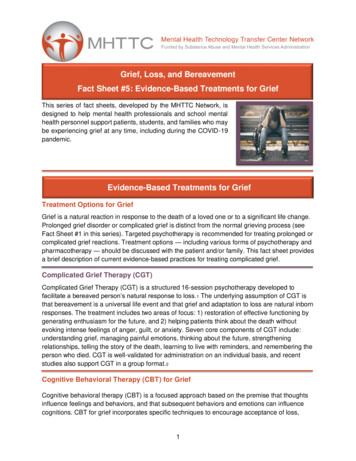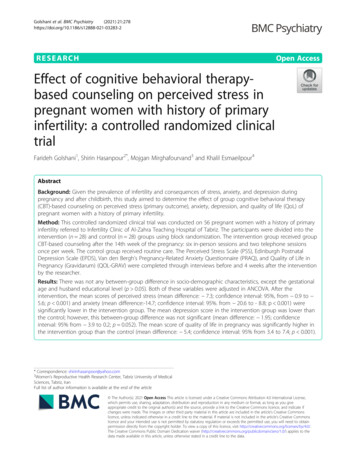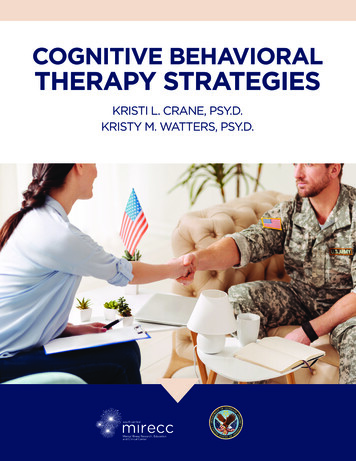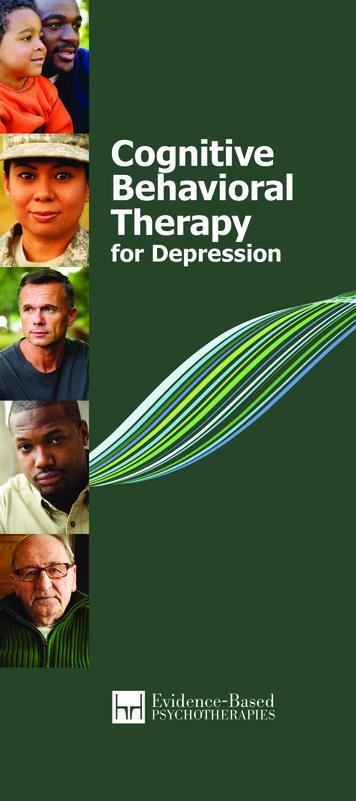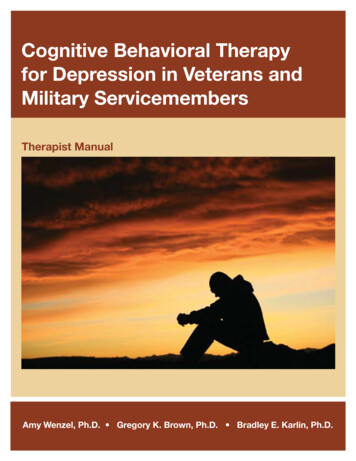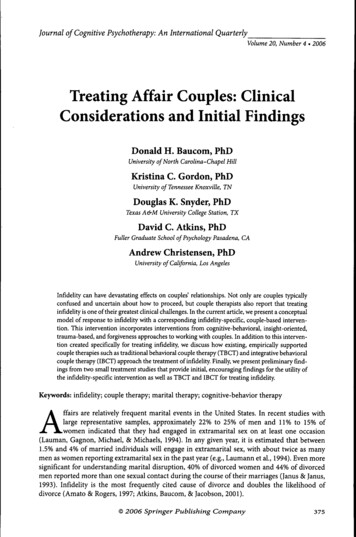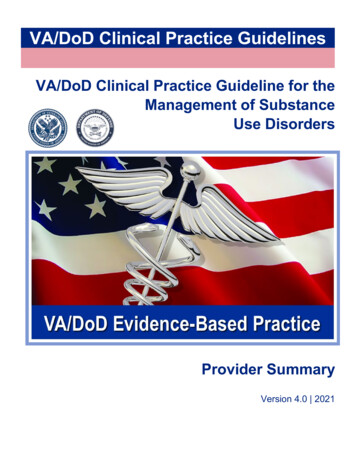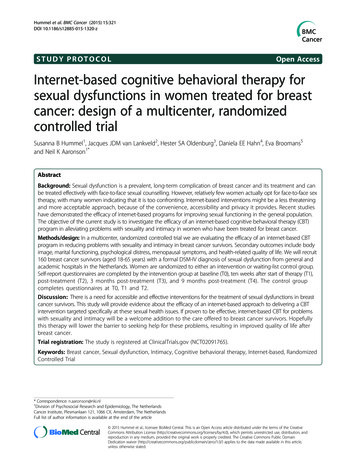
Transcription
Hummel et al. BMC Cancer (2015) 15:321DOI 10.1186/s12885-015-1320-zSTUDY PROTOCOLOpen AccessInternet-based cognitive behavioral therapy forsexual dysfunctions in women treated for breastcancer: design of a multicenter, randomizedcontrolled trialSusanna B Hummel1, Jacques JDM van Lankveld2, Hester SA Oldenburg3, Daniela EE Hahn4, Eva Broomans5and Neil K Aaronson1*AbstractBackground: Sexual dysfunction is a prevalent, long-term complication of breast cancer and its treatment and canbe treated effectively with face-to-face sexual counselling. However, relatively few women actually opt for face-to-face sextherapy, with many women indicating that it is too confronting. Internet-based interventions might be a less threateningand more acceptable approach, because of the convenience, accessibility and privacy it provides. Recent studieshave demonstrated the efficacy of internet-based programs for improving sexual functioning in the general population.The objective of the current study is to investigate the efficacy of an internet-based cognitive behavioral therapy (CBT)program in alleviating problems with sexuality and intimacy in women who have been treated for breast cancer.Methods/design: In a multicenter, randomized controlled trial we are evaluating the efficacy of an internet-based CBTprogram in reducing problems with sexuality and intimacy in breast cancer survivors. Secondary outcomes include bodyimage, marital functioning, psychological distress, menopausal symptoms, and health-related quality of life. We will recruit160 breast cancer survivors (aged 18-65 years) with a formal DSM-IV diagnosis of sexual dysfunction from general andacademic hospitals in the Netherlands. Women are randomized to either an intervention or waiting-list control group.Self-report questionnaires are completed by the intervention group at baseline (T0), ten weeks after start of therapy (T1),post-treatment (T2), 3 months post-treatment (T3), and 9 months post-treatment (T4). The control groupcompletes questionnaires at T0, T1 and T2.Discussion: There is a need for accessible and effective interventions for the treatment of sexual dysfunctions in breastcancer survivors. This study will provide evidence about the efficacy of an internet-based approach to delivering a CBTintervention targeted specifically at these sexual health issues. If proven to be effective, internet-based CBT for problemswith sexuality and intimacy will be a welcome addition to the care offered to breast cancer survivors. Hopefullythis therapy will lower the barrier to seeking help for these problems, resulting in improved quality of life afterbreast cancer.Trial registration: The study is registered at ClinicalTrials.gov (NCT02091765).Keywords: Breast cancer, Sexual dysfunction, Intimacy, Cognitive behavioral therapy, Internet-based, RandomizedControlled Trial* Correspondence: n.aaronson@nki.nl1Division of Psychosocial Research and Epidemiology, The NetherlandsCancer Institute, Plesmanlaan 121, 1066 CX, Amsterdam, The NetherlandsFull list of author information is available at the end of the article 2015 Hummel et al.; licensee BioMed Central. This is an Open Access article distributed under the terms of the CreativeCommons Attribution License (http://creativecommons.org/licenses/by/4.0), which permits unrestricted use, distribution, andreproduction in any medium, provided the original work is properly credited. The Creative Commons Public DomainDedication waiver ) applies to the data made available in this article,unless otherwise stated.
Hummel et al. BMC Cancer (2015) 15:321BackgroundBreast cancer is the most common type of cancer amongwomen in the Netherlands [1]. Improved breast cancerscreening and treatment have resulted in increased survival rates [2]. Consequently, more interest and researchhas focused on the health-related quality of life (HRQL)of breast cancer survivors, including issues of sexualityand intimacy.The prevalence rates for sexual dysfunctions as a result ofbreast cancer treatment vary between 30% and 100% [3-7].Breast cancer survivors (BCS) experience worse sexualfunctioning compared to women without a history of cancer [8-10]. Frequently reported problems include decreasedsexual desire (23-64%), decreased sexual arousal or vaginallubrication (20-48%), anorgasmia (16-36%) and dyspareunia(35-38%) [3].The different components of breast cancer treatment canall directly or indirectly affect sexual functioning [3]. Previous studies have shown that women who have receivedchemotherapy are at a higher risk of developing sexual dysfunctions than women who have not undergone this treatment [8,11-17], regardless of the type of surgery [14,18].Chemotherapy can cause premature, abrupt menopause,leading to reduced sexual desire in some women [19]. Itcan also induce vaginal dryness and atrophy, which subsequently can affect sexual functioning [6,8,12,13,15,20]. Results with regard to endocrine treatment are somewhatmixed, but studies show that tamoxifen and aromataseinhibitors can lead to sexual problems [21-27]. The evidence pertaining to the effect of surgery on sexual functioning is mixed [28-30], with some studies showing thatwomen who undergo a mastectomy report more problemsin sexual functioning than women who receive breastconserving therapy [28,31,32], while other studies havenot found an association between type of surgery andsexual functioning [18,29]. More consistent is the findingthat mastectomy more often results in compromised bodyimage than does breast conserving treatment [4,13,28].Other common complaints after breast cancer treatmentare concerns about sexual attractiveness and femininity, fatigue, anxiety and depression, fear of loss of fertility, andoverall decreased HRQL [3,18,33,34]. Emotional well-beingand the quality of the partner-relationship can also be affected by the distress surrounding diagnosis and treatment[35-37]. Although the diagnosis and treatment of any typeof cancer can cause problems in sexual functioning [3],breast cancer raises particular concerns because of the importance of the breast in feminine sexuality and the breastas a source of erotic pleasure and stimulation [33].Sexual dysfunctions can be treated effectively with faceto-face forms of sex therapy [38-41]. Sex therapy typicallycomprises a flexible treatment program including a numberof elements that can be tailored to the needs of individualsand couples. It typically involves behavioral componentsPage 2 of 12derived from the sex therapy developed by Masters andJohnson [42], i.e. psycho-education about sexuality and sexual dysfunction, a temporary ban on intercourse, and sensate focus exercises. A ban on intercourse can break thevicious cycle of fear of sexual intercourse and subsequentnegative experience and disappointment, and offers the opportunity for positive experiences by eliminating or reducing performance demand [43]. Sensate focus exercisesform a hierarchically structured exercise program, throughwhich partners gradually reintroduce the consecutivephases of sexual contact. The exercises are targeted at becoming more comfortable with one’s own body and achieving sexual intimacy with one’s partner, both physically andemotionally. Other goals are to discover new approaches tosexual stimulation, and to encourage communication between partners about sexual experiences, sexual desires andsexual boundaries. These behavioral elements of sex therapy are usually combined with cognitive therapy [40,43].Through cognitive therapy, therapist and client aim to detect and modify the client’s dysfunctional, disturbing cognitions regarding sexuality that arise during exercises. Via themethod of cognitive restructuring, the dysfunctional cognitions are replaced by more functional appraisals. Sex therapy is often delivered in a couple format, but individualapplications and group therapy formats are also describedin the literature [44,45].The efficacy of different types of face-to-face therapyfor female sexual dysfunction (FSD) has been demonstrated, including sexual desire and sexual arousal disorder [40,46,47], orgasmic disorder [48,49], sexual pain[50,51], and vaginismus [52,53]. Several modified treatmentprograms have been developed and evaluated for breastcancer survivors [44,54]. Interventions with stronger effectstend to be couple-focused and include treatment components that educate both partners about the woman’s diagnosis and treatment, promote couples’ mutual coping andsupport processes, and include treatment components thatmake use of specific sex therapy techniques addressing sexual and body image concerns [44,54].Despite the availability of effective treatments for sexualdysfunctions, there is a significant discrepancy between theself-reported need for professional sexual health care incancer survivors and the actual uptake of care [5,55]. Keddeet al. [5] reported that only 40% of BCS who felt a need forcare actually consulted a health professional. Hill et al. [55]reported that, although over 40% of gynaecologic cancerand breast cancer survivors expressed interest in receivingprofessional care, only 7% had ever actually sought suchcare.Although sexual functioning is an important issue,health care professionals may be reluctant to query breastcancer patients about sexual problems during medicalconsultations, due to time constraints, embarrassment,lack of knowledge and experience in this area, and/or lack
Hummel et al. BMC Cancer (2015) 15:321of resources to provide support if needed [56,57]. It mayalso be difficult for patients to initiate discussion abouttheir sexual difficulties with their health care professional[58-60]. It has been suggested that when reporting sensitive or potentially stigmatizing information, individualsmay feel more comfortable undergoing assessment andtreatment via the internet [61,62]. This idea is supportedby a survey [de Blok G. Thesis on the outpatient clinic forsexuality and breast cancer of The Netherlands CancerInstitute. Unpublished manuscript] that was conducted inwomen who attended an informational meeting of a sexuality and breast cancer clinic, but who subsequently didnot follow-up for an appointment for face-to-face counselling. While some women indicated that they did not consider treatment of their sexual problems to be necessary,others indicated that they did not wish to undergo suchtreatment in a hospital-setting, or that the face-to-face setting of the counselling formed too great a barrier. Manyrespondents suggested that internet-based therapy wouldbe a less threatening and more acceptable approach. Theadvantages of internet-based therapy include privacy, convenience and accessibility [63-65], all of which may be particularly attractive in the area of sexual problems.There is growing evidence that internet-based CBT is aneffective method to treat a range of psychosocial problems[66-73]. More recently, internet-based CBT programsfor sexual dysfunctions have been developed and tested[45,65,74-77]. However, most of these online interventionshave focused on male sexual dysfunctions [74,75,77-80].Early trials have demonstrated the applicability and effectiveness of online CBT for FSD in the general population[76], and of an online intervention for sexual problems inbreast cancer survivors [81]. However, the efficacy of aninternet-based CBT for sexual problems in BCS has notyet been researched.In this article, we describe the design of a randomized,controlled, multicenter trial that evaluates the efficacy of aninternet-based CBT program for sexual dysfunctions inwomen who have been treated for breast cancer. Wehypothesize that women in the internet-based CBT groupwill report a significantly greater improvement in sexualfunctioning and intimacy than women in a waiting-list control group. Secondarily, we hypothesize that women whoundergo the internet-based CBT will report significantlyless psychological distress and fewer menopausal symptoms, and a significantly greater improvement in bodyimage, marital functioning and HRQL than women in thecontrol group.MethodsIn this study, patients are randomized to either an intervention group or a waiting-list control group. Women in theintervention group will undergo an internet-based CBTaimed at alleviating problems with sexuality and intimacy.Page 3 of 12The design of the trial and the anticipated flow of participants are displayed in Figure 1. The trial has been approvedby the Institutional Review Board of The NetherlandsCancer Institute (under number NL44153.031.13), as wellas by all review boards of the hospitals from which patientsare being recruited (for a list of the participating hospitals,see the Acknowledgements section). Patient recruitmentand data collection started in September, 2013.Study sampleThe study sample will be composed of 160 women fulfilling the following inclusion criteria: (1) age 18-65 years(the upper limit of 65 years is not based on any assumption regarding the salience of sexuality with increasingage, but on the smaller chance of access to internet inthis age group); (2) a history of histologically confirmedbreast cancer (stages: T1-T4, N0-N1 and M0); (3) a diagnosis of breast cancer six months to five years prior tostudy entry; (4) completion of breast cancer treatment(with the exception of endocrine therapy and immunotherapy); (5) disease-free at time of study entry; (6) abasic fluency in the Dutch language (for assessment andtherapy purposes); and (7) a formal diagnosis of sexualdysfunction according to the criteria of the Diagnosticand Statistical Manual of Mental Disorders-IV [82] (tobe established by an experienced sexologist during an intake interview). Single as well as partnered women canparticipate in the study. Sexual orientation is irrelevantfor eligibility.Exclusion criteria are: (1) no access to internet; (2) serious cognitive or psychiatric problems (i.e., depression,alcohol dependency, or psychotic disorders) as determined on the basis of the Mini International Neuropsychiatric Interview [83]; (3) treatment for another typeof cancer (with the exception of cervix carcinoma in situand basal cell carcinoma); (4) presence of severe relationship problems for which the internet-based programis not appropriate; (5) participation in a concurrent therapy program to alleviate problems with sexuality or intimacy; (6) participation in a concurrent CBT programfor other psychological problems; and (7) participationin another trial investigating problems with sexuality/intimacy.Recruitment and randomizationPatients are recruited from 10 community and universityhospitals in the Netherlands and are identified throughthe hospital registries by their physician, or by means ofthe database of the Netherlands Cancer Registry. Selected patients are sent an invitation letter describingthe study and internet-based therapy, and are asked toreturn a response card to indicate if they are interestedin participation. In case of no interest, women are askedto specify their reason(s) for this on the card. In the
Hummel et al. BMC Cancer (2015) 15:321Page 4 of 12Patients receive invitation letter and response cardNo response/declinesScreening by telephone by member of research staffIneligible/withdrawsIntake evaluation by telephone by sexologistIneligible/withdrawsPatients receive baseline questionnaire (T0)No response/withdrawsPatients who complete baseline questionnaireNo informed consentBooklet10 weeksStart CBT8 weeksTelephone callT2Finish CBTT2Start CBT3 months4 weeks10 weeksT16 monthsT3T4Figure 1 Overview of study procedures. *The total duration of study participation is dependent on the duration of the CBT.23 weeks7 weeksTelephone call from sexologistT159-63 weeks*Control group6 weeksIntervention group2 wk3 weeksPatients randomized
Hummel et al. BMC Cancer (2015) 15:321absence of a response, a reminder is sent three weeksafter the first mailing. Women who are not interested inparticipation or who do not respond to the reminder arenot contacted again.Interested women are screened for eligibility twice: firstby a member of the study staff and subsequently by a sexologist. In these interviews, more information about thestudy procedures and therapy is given and eligibility criteriaare checked. The sexologist carries out a diagnostic interview to determine final eligibility of the woman, and theMini International Neuropsychiatric Interview [83] is completed. All sexologists involved in the study are female, andhave undergone special training in the application of theinternet-based CBT program.Eligible women are sent a baseline questionnaire (T0)and an informed consent form. Study questionnaires canbe completed online or in a paper-and-pencil format. Thebaseline questionnaire assesses sociodemographic and medical background variables, and the study outcomes. If thescore of the marital adjustment subscale of the MaudsleyMarital Questionnaire [84] (see ‘Study measures’ section)exceeds the cut-off score of 35, the eligibility of the participant is discussed once more with the sexologists to determine if the nature and severity of the relationship problemswould recommend treating these problems prior to tacklingthe sexual dysfunction, thus resulting in exclusion fromstudy participation.Consenting women are randomized to either an intervention group (n 80) or a waiting-list control group (n 80)using the minimization technique, with type of surgery(breast conserving therapy; mastectomy only; mastectomywith breast reconstructive surgery), current endocrine treatment for breast cancer (yes; no), time since breast cancerdiagnosis ( 1 year; 1-3 yrs; 3-5 yrs), and menopausal status(premenopausal; postmenopausal) as stratification variables.Study armsIntervention group: internet-based CBT programEach woman is assigned a sexologist who guides herthrough the internet-based CBT program. Contact with thetherapist is web-based, via a secured, password-protectedwebsite. From a total of 10 modules, the sexologist selectsfour to five modules that best fit the sexual problems of theclient. The internet-based CBT program was originally developed for use in the general population at Virenze, amental health center located in Utrecht, the Netherlands.The program was adapted for use specifically for breastcancer survivors. This involved editing and adding text related to the physical and psychosexual problems often experienced by women who have had breast cancer. Thetherapists are licensed psychologists and sexologists whohave undergone additional training in issues relating tobreast cancer, and in the use of the internet program.Page 5 of 12A description of the content of the different programmodules is provided in Table 1. Each module containsseveral interventions, each of which comprises the following elements: (1) introduction, (2) psycho-education, (3)“homework” assignments (e.g., registration exercises; discuss intimacy with partner; sensate focus exercises) and (4)reporting back to the therapist and receiving feedback onthe homework assignments. The modules can be used invarying order, leading to a tailored and flexible treatmentprogram consisting of a maximum of 20 therapy sessionsthat are completed within a period of 24 weeks. A minimum of five sessions is considered the lower limit of sessions required in order to expect an effect. The averagetime investment for a participant is 90-120 minutes perweek. Women are motivated by the sexologist to involvetheir partner in the treatment, but partner involvement isnot mandatory. The time limit within which the therapistshould respond to incoming messages from a client is set atfive working days. Weekly contact between therapist andclient is pursued. After 10 weeks of treatment, a mid-termevaluation is held to reflect on the progress so far, and toadjust goals, if necessary, for the remaining part of treatment. The internet-based CBT program is provided at nocost to the woman.Waiting-list control groupParticipants in the control group are asked to refrain fromundergoing any psychological or medical interventions forsexual problems during their participation in the study. Toincrease the likelihood that women will remain in the studyuntil they are offered the CBT program, they are providedwith a booklet addressing questions about sexuality andcancer. Additionally, six weeks after randomization andupon completion of the second questionnaire, women inthe control group are contacted by telephone to addressany questions or comments that they may have about theirparticipation in the study, and to reconfirm that they willbe eligible for the internet-based CBT program upon theircompletion of the study.Data collectionPatientsPatients in both study arms complete a battery of selfreport questionnaires at equivalent moments in timefor the first three assessments (T0: baseline; T1:10 weeks after start of therapy (intervention group) or13 weeks after randomization (control group); and T2:post-treatment (intervention group) or 23 weeks afterrandomization (control group), see Figure 1). Toachieve an equivalent average assessment time for bothgroups, women in the intervention group complete T2post-treatment, but always between 20 and 24 weeksafter start of therapy. Women who finish the CBT priorto 20 weeks complete T2 20 weeks after start of
Hummel et al. BMC Cancer (2015) 15:321Page 6 of 12Table 1 Description of therapy modulesModule 1: Put your problem into wordsIn this module the client describes her sexual problems, and learns how sexuality can beinfluenced by the treatment of breast cancer. The sexual response curve and female sexualdysfunctions are elaborated on. Furthermore, information is given about what intimacy is andhow it interplays with sexuality. Women are encouraged to discuss their sexual problems withtheir partner.Module 2: How is my relationship doing?In this module the client explores the level of intimacy in her relationship, becomes aware ofthe amount of quality time spent with the partner, and receives psycho-education about sexand intimacy. The importance of open communication with the partner is discussed, and advice isgiven on how to improve communication with regard to intimacy and in particular sex. The coupleevaluates how their relationship and sex life has been influenced by the diagnosis and treatment ofbreast cancer.Module 3: Sex and my bodyIn this module sensate focus therapy is introduced. The first steps of the hierarchicallystructured exercise program are completed. An introduction is given with regard to theinfluence of thoughts and external stimuli on the experience of sex. Attention is also paid topossible tension in the pelvic floor and methods to relax this part of the body.Module 4: Focus my attentionIn this module the client receives task concentration training in order to learn to focus herattention on sexual experiences in such a way that it is beneficial to the client.Module 5: Explore my bodyIn this module sensate focus therapy is elaborated on and the hierarchically structuredexercise program is completed. The client reports on her experiences with the homeworkexercise within a cognitive behavioral framework.Module 6: Discovering my sexual arousalfeelings (version for male partners)The topics of this module are similar to the female version (see module 7), but are writtenfrom a male perspective.Module 7: Discovering my sexual arousalfeelings (female version)In this module psycho-education is provided about the female body and genitals, female sexualdysfunction, genital stimulation, sexual techniques, and the male body and genitals. Accompanyingexercises are provided for each subject, including, for example, exposure exercises for sexualpain disorders. Attention is also paid to the importance of and ways to discuss sexual feelings andpreferences with the partner.Module 8: Change my thoughtsIn this module the influence of thoughts on feelings and behavior is explained, and theclient’s dysfunctional cognitions with regard to sex and intimacy are identified. Via the methodof cognitive restructuring these cognitions are replaced by more functional, adaptive thoughts.Module 9: My sexual preferencesIn this module the client’s sexual development, sexual needs, myths and beliefs about sex areevaluated. The client is encouraged to talk about her sexual preferences with her partner, andan action plan for behavior change is created.Module 10: Relapse preventionIn this module the client reflects on her former automatic behavior and possible risk factors forrelapse. A plan of action is generated to use in the event of a relapse.therapy. Women in the intervention group alsocomplete questionnaires three months post-treatment(T3) and nine months post-treatment (T4). The controlgroup is not asked to complete T3 or T4, but rather isgiven the opportunity to undergo the intervention followingcompletion of T2. This was done because it was notdeemed ethically acceptable to withhold the interventionfrom women in the control group for the prolonged periodof time that would be required if they were to complete allfollow-up questionnaires (i.e., approximately one year afterstudy enrollment). To minimize respondent burden, the T4questionnaire only includes the questionnaires assessingthe primary outcome measures. In every questionnaire,women in both the intervention group and control groupare asked if they pursued any other activities to reduce theirsexual problems (e.g., use of vaginal lubricant, relaxationexercises). A reminder is sent to participants who do notcomplete and return the questionnaire within one week. Ifa woman does not complete the questionnaire in the weekafter the reminder, she is contacted by telephone.PartnersOnly partners of the women in the intervention group areasked to complete questionnaires regarding problems withsexuality and intimacy (male partner: IIEF [85], female partner: FSFI [86]), and relational functioning (PAIR Inventory[87], MMQ [84]) at the same points in time as theparticipants.Study measuresSociodemographic and clinical dataSociodemographic data and clinical data are obtained during the screening interview and via the baseline questionnaire. Sociodemographic data include age, education,relational status, living situation and work status. Clinicaldata are collected from the medical records and viaself-report, and include date of breast cancer diagnosis,treatment (type of surgery, chemotherapy, radiotherapy,endocrine therapy, immunotherapy), medication useand comorbidity.
Hummel et al. BMC Cancer (2015) 15:321Outcome measuresDetailed descriptions of the outcome measures are provided in Table 2. Briefly, the primary outcome measures include standardized self-report questionnaires assessingproblems with sexuality and intimacy. These include theSexual Activity Questionnaire [88,89], the Female SexualFunction Index [86,90], the Female Sexual DistressScale-Revised [91] and the PAIR Inventory [87]. Secondary outcome measures include standardized selfreport questionnaires assessing body image (EORTCQLQ-BR 23 Body image subscale [92]), menopausalsymptoms (FACT-ES ESS-18 [93]), marital functioning(MMQ [84]), psychological distress (HADS [94,95])and HRQL (SF-36 [96,97]). The International Index ofErectile Function [85] is used to assess sexual functioning in male partners.Compliance with the internet-based CBT programThe level of compliance is established via a question that isposed to the sexologist at the completion of therapy: ‘Howmany of the total number of therapy sessions that you considered to be optimal for this client has the client actuallycompleted?’. This question is answered on a five-pointscale, ranging from ‘the client has done all of the sessions Ideemed necessary (100%)’ to ‘the client has not/barely donethe sessions I deemed necessary (less than 25%)’. Additionally, the actual number of completed modules and interventions are extracted from the client’s records at the mentalhealth center where the internet program is housed. Additionally, at completion of therapy, both the client and thesexologist are asked to indicate the frequency with whichhomework assignments were completed on a five-pointscale (always-frequently-occasionally-rarely-never), and toindicate the reasons for not completing all homework assignments, if applicable. Women who do not complete theinternet-based CBT program are asked to indicate theirreason(s) for discontinuation (e.g., therapy was too intensive, online therapy was not suitable, illness). Every effortwill be made to obtain all questionnaires of all participants,regardless of whether they do or do not complete theirtherapy.Patients’ evaluation of the intervention programUpon completion of the CBT, women in the intervention group are asked to complete an evaluation questionnaire about the program. Questions are posed abouttheir satisfaction with the program, the perceived efficacy of the program in alleviating sexual problems, theirsatisfaction with the choice of modules and exercises,the usability of the program, if they would recommendthe treatment to other women experiencing similarproblems, and if they would suggest any changes to theprogram. Women who discontinue the CBT programare asked the same questions.Page 7 of 12A subset of women (approximately 15 from the intervention group) will be asked to participate in an evaluationinterview by telephone. This semi-structured interviewcovers the same topic areas as addressed by the self-reportevaluation questionnaire, allowing women to provide feedback in a more narrative form. Where applicable, womenwill also be asked if their partner would be willing to sharehis or her experience with the program.Statistical issuesPower calculationThe SAQ, FSFI, FSDS-R and PAIR Inventory are the primary outcome measures on which sample size calculations are based. With a total sample of 130 women (65per group), and under the assumption of no interaction,the st
These behavioral elements of sex ther-apy are usually combined with cognitive therapy [40,43]. Through cognitive therapy, therapist and client aim to de-tect and modify the client ’s dysfunctional, disturbing cogni-tions regarding sexuality that arise during exercises. Via the method of c
